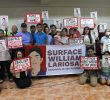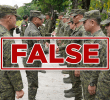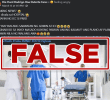by Sheila Coronel*
IN THE PHILIPPINES, the end of Ferdinand Marcos’s 20-year dictatorship in 1986 was a tumultuous time. The new government of Corazon Aquino was being challenged on all fronts: from the Right, by ambitious military factions plotting coups; from the Left, by peasant guerrillas and angry protesters demanding radical reforms. In those days, I was working as a journalist in Manila, finally able to cover the country’s problems with corruption, crime, economic stagnation, and insurgency without fear of censors.
In 1987 and 1988, I made several trips to Davao, a sprawling city on Mindanao’s southeastern coast, to report on the convulsions rocking that city. Back then, Davao was known not so much for its balmy breezes, rich fisheries, and expansive plantations, but for a brutal campaign against a communist insurgency, sparked by widespread military abuses during the Marcos regime and longstanding problems of poverty and inequality. The breakdown in law and order had also made it a fertile breeding ground for crime. “Each day, some two to three people were killed and thrown in a ditch,” one longtime resident said. Agdao, the city’s biggest slum, was famously called “Nicaragdao.” The streets were gridded with checkpoints manned by nervous soldiers, their Armalites at the ready. But that didn’t deter unknown gunmen from shooting criminals and policemen, often in broad daylight. In 1985, Asiaweek branded Davao “Murder City.”
36 Killings a Day in the Philippines
One late evening in September of 1988, a colleague and I went on a ride-along with the newly elected mayor of Davao, a 43-year old former prosecutor and vice-mayor named Rodrigo Duterte, to learn about his plans to fix Davao. As we patrolled the streets in his van, his bodyguards kept watch, the nozzles of their rifles peeking out of the vehicle’s windows. Throughout our ride, Duterte offered an invective-laced running commentary about the challenges of maintaining law and order in his rough-and-tumble city. There was a notorious drug dealer, he said, who had been rushed to the local hospital, wounded and bloodied, following a shootout with the police. The drug dealer was still alive, he said. So he went to the hospital and unplugged the life support system. My colleague on the ride-along that night recalled another story: Duterte claimed to have pushed a drug dealer out of a helicopter. I don’t know whether any of his stories, loaded with blood-curdling hyperbole, were true or told merely for dramatic effect. What I do know is that amid the anarchy of Davao in the 1980s, these stories were far from the most chilling that I heard.
In May, Duterte, who would serve as Davao’s mayor for 21 years, was elected president of the Philippines, defeating four other challengers with a promise to purge the country of drug dealers. Already in his first two months in office, police and vigilantes have reportedly gunned down some 2,000 suspected drug dealers, apparently heeding Duterte’s vow during his inauguration that the fight against drugs would be “relentless.” Despite growing criticism from human rights groups in the Philippines and overseas, he has not backed down. “I will not stop until the last pusher on the streets is fully exterminated,” he said on Monday. “I will kill all the drug lords. Make no bones about it.”
To Duterte and his supporters, Davao—once a haven for communist rebels, Muslim secessionists, and assorted criminals, and now one of the Philippines’s safest, most prosperous urban areas—is living testament to this take-no-prisoners approach. Duterte has staked his presidency on the presumption that if Davaeños were willing to pay such a steep price for law and order, most other Filipinos will be as well. You can think of Duterte, then, as the bastard child of Philippine democracy. If he is to be understood at all, it’s as a product of the bloody, messy democratic transition on Mindanao, the country’s conflict-torn southernmost island.
But Duterte’s version of success came with a price. There is a curfew for minors, and a ban on late-night liquor sales. Unlike in the rest of the country, traffic rules and city ordinances are strictly enforced in Davao. More menacingly, human rights groups say that Duterte’s office facilitated the creation of the Davao Death Squad, a group of vigilantes composed of local thugs, former rebels, and ex-soldiers and policemen. Between 1998 and 2015, the death squad allegedly killed over 1,400 petty criminals and street children in Davao.
Last week, in chilling testimony before the Philippine Senate, a man named Edgar Matobato testified that he was part of the Davao Death Squad, a group formed in 1988, the year Duterte became mayor. Matobato said that he and other death squad members were on the city’s payroll, and that they targeted suspected drug dealers, rapists, and bag snatchers. In 1993, he threw a grenade at a mosque, after suspected Islamists bombed the Davao cathedral. In one of his testimony’s numerous horrific moments, he claimed that he chopped up the corpses of victims, fed them to crocodiles, or buried them in a quarry. Duterte dismissed these stories as “the accusations of a madman.”
* * *
Extreme as Duterte’s provocations may be, they resonate with deep-set anxieties in the Philippines. The rule of law is weak and the police and the courts are widely considered by citizens to be unreliable and corrupt. Last year, a national poll found that even while the rate of crime victimization was falling, the sense of insecurity continued. While the Philippines is far from being a narco-state, the trade in methamphetamines is brisk and conducted in the light of day, and the government is seen as helpless to curb it. Across the country, both poor and middle-class families are concerned about drug addiction, yet the traditional political elites have mostly been indifferent to it, failing to address festering problems of law and order. Little wonder that Duterte was cheered on when he vowed to pull out all the stops in the war against drugs.
Duterte is of a type familiar in the Philippines: one of many local strongmen that have thrived in the fetid swamp of the country’s feudal politics. He emerged from a clan of savvy provincial bosses who prospered in the country’s southern frontier through the skillful deployment of patronage and violence. He is also the first Philippine president from Mindanao, and brings to the office a proud Mindanaon’s disdain for faraway “imperial Manila.”
Residents transport on a trolley two bodies of men killed by policemen. (Ezra Acayan / Reuters)
Duterte certainly lacks the urbane pedigree of his two predecessors, Benigno Aquino III and the Georgetown-educated Gloria Macapagal-Arroyo, both the progeny of presidents past. They are the Filipino elite, comfortable in Washington’s embrace and the salons of Manila society. Duterte’s uncouthness and vulgarity, by contrast, are the source of his broad appeal. His supporters applaud his vulgar rhetoric, so different from that of the feckless and fork-tongued politicians who have failed to address the country’s myriad problems.
* * *
To understand what seems to validate Duterte’s seemingly maniacal thirst for blood in the pursuit of order, you’ve got to grapple with the world that shaped him when he entered public life in the 1980s, at the height of the anti-communist campaign. In Davao in the early 1980s, guerrillas tested urban warfare strategies on the city’s streets. They deployed “sparrows,” or assassins who gunned down policemen and criminals in broad daylight. Both in Davao and across Mindanao, the communists purged their ranks of suspected military informers, torturing and killing hundreds of innocent cadres.
Unless you saw the madness with your own eyes, it was hard to believe. On one trip to Davao, I found a city terrorized by bands of vigilantes, roaming the streets with guns or long knives, hunting for communists. The radio blared anti-communist tirades, the most incendiary of them from Jun Pala, a broadcaster who compared himself to Goebbels. Pala walked around Davao armed with a Magnum revolver and a hand grenade. On air, he threatened to behead rebel sympathizers and egged on the vigilantes as they gunned down or knifed suspected communists. One day, news photographers chanced upon a vigilante band that had beheaded a suspected guerrilla. The killers posed for pictures, and said they drank the blood from the sundered head.
Davao was then a laboratory for a counterinsurgency strategy involving arming civilians, many of them recruited from the city’s criminal underworld, and setting them loose in poor communities where the insurgents still enjoyed strong support. This strategy had the tacit endorsement of Washington: The United States trained Filipino military officers in counterinsurgency and sent millions in military assistance for the anti-communist campaign, including a $10-million grant to the Philippine army for “the planting of news stories and the creation of new political groups.”
Amid the murder and mayhem, Duterte was the city’s only hope. Within a few years, he had neutralized the already-weakened communists by intimidating the recalcitrants among their ranks and driving them away from the city if they hadn’t already been killed by the vigilantes. The rest, he offered jobs, including in the city government. He won the backing of the Davao elite, as improved peace and order allowed their businesses to thrive. He was conciliatory toward Muslim separatists and got the support of NGOs for programs that provided services for the city’s poor. Today, Davao is a peaceful and booming commercial and tourist hub.
Duterte appears to be betting that what worked in Davao then will work for the rest of the country now.
The dark side of this was the masked gunmen he is said to have enlisted, some of them former communist guerrillas or local thugs, who targeted drug users, petty criminals, and the occasional critic—like the broadcaster Pala. By the early 2000s, Pala had begun aiming his incendiary broadcasts at Duterte, accusing him of “a reign of terror.” In 2003, as he was on his way home from work, Pala was shot multiple times in the chest and head by two men riding pillion on a motorcycle. Matobato, the former death squad member, said Duterte himself had ordered Pala’s murder.
Duterte appears to be betting that what worked in Davao then will work for the rest of the country now. And that’s where the problem lies. It’s hard to rein in a nation of 100 million people (Davao’s population is under 2 million). Despite the political turbulence since the fall of Marcos, the Philippines today has a pluralistic political culture, a feisty press, and vibrant civil society. As the Senate hearings on the Davao killings illustrate, the checks and balances sometimes work, and there’s always noisy opposition eager to stymie the powerful. In many ways, Duterte is a throwback to a dark era that the country has left behind. He’s a man out of time.
As president, Duterte now occupies a bigger, international stage, where the bombast he deployed to great effect at home is unlikely to play well. Yet he’s found a way to extrapolate Dutertism to accommodate his new venue, for now at least. In August, he threatened to pull out of the United Nations after Secretary-General Ban Ki-Moon condemned his apparent endorsement of extrajudicial killings. In his expletive-laden tirade against the U.N., he threatened to join China and African countries in forming a new international body. Two weeks later, when asked whether the President Barack Obama might raise the subject of human rights with him at a regional summit in Laos, he called him a “son of a bitch.”
In another move seemingly tailor-made to troll Washington, Duterte is cozying up to China, despite a longstanding legal dispute between the Philippines and China over contested islands in the South China Sea. On September 9, he told an audience in Indonesia that he “didn’t give a shit” what the international community thought of him because he wasn’t president of the international community. That remark may go over well with some of his fans at home, but it denies the reality that remittances from millions of Filipinos working overseas are propping up the local economy; the country is no longer as insular as it was in the 1980s, and young Filipinos, like others of their generation, have a more global outlook. The ties that bind the Philippines to its former colonizer remain strong: There are 4 million Filipinos in America, and the Philippines’s military continues to depend on the U.S. support for its naval defense and counter-terrorism operations.
In Davao, which has benefitted from both U.S. development aid and a brisk trade in agricultural produce with China, Duterte did not have to concern himself with foreign policy. In the presidential palace, however, things are more complicated. Casual presidential pronouncements take on the weight of official policy, whether Duterte means them to or not. It’s hard to tell whether the new president is reinventing the Philippines’s foreign policy, or merely thumping his chest.
And therein lies the Duterte conundrum: If he becomes the voice of moderation, then he loses his distinctiveness and muscular appeal. He risks becoming one of the mealy-mouthed politicians he so detests. If he wants to remain true to his beliefs, he must find a way to articulate his position on human rights, foreign policy, and the international community that goes beyond expletives. He’s in uncharted territory now. The Davao playbook no longer suffices. It’s time to write a new one.
—————————————————————————————————————————-
*Note: This report was published today as the cover story of The Atlantic magazine, which runs news and analysis on politics, business, culture, technology, national, international issues and life.
The author was the founding executive director and remains a member of the Board of Editors of the Philippine Center for Investigative Journalism. She is now the Toni Stabile Professor of Professional Practice in Investigative Journalism and Dean of Academic Affairs at Columbia School of Journalism in New York.










